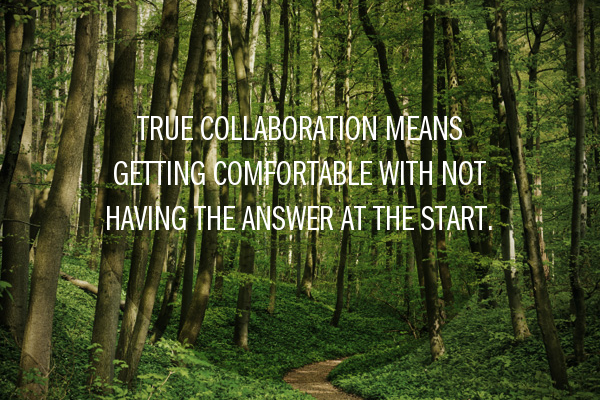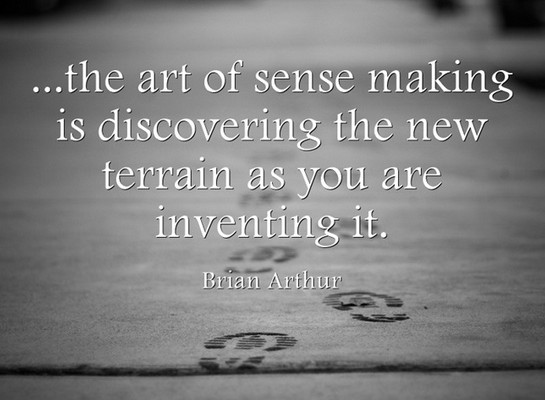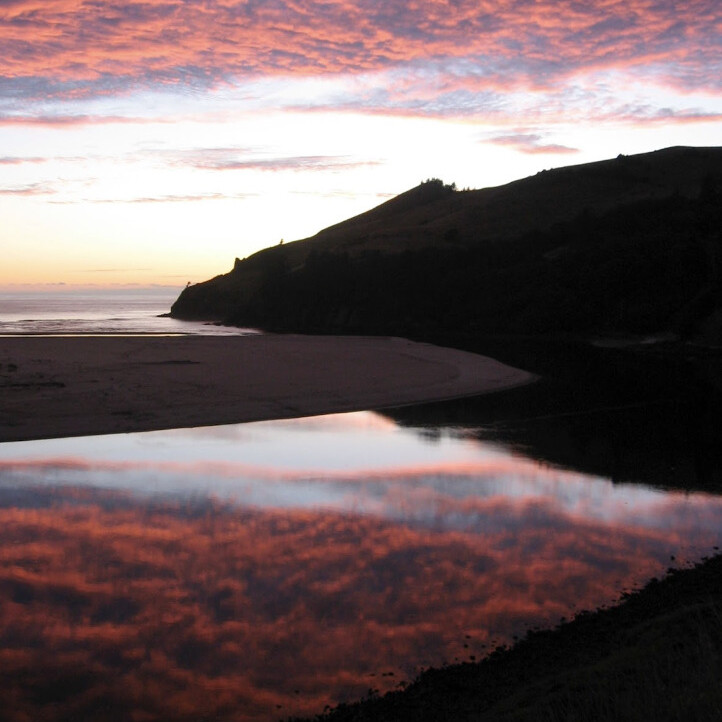PART 1
Investing in Collaboration

A client recently called us her “network therapists.” She works for a foundation and was helping launch a network. The foundation saw that if organizations in a region could work in a networked way they could achieve greater impact and have a stronger political voice. However, the organizations had to find the value in working together – it had to come from them – or the network would not work. Our client experienced the discomfort of wanting a concrete plan and answers while we were in the stage of creating the space for the participants to come to those answers together. Investing in true collaboration meant we asked the question of the group, and had to be open to what their answer was, even if they concluded they did not see value in creating a network.
In a similar example, the Executive Director of an environmental non-profit asked for our help in bringing together many organizations working on a specific environmental problem to align their work and create a network. He recently said to me, “What I really want is to get everyone invested and agreed on the direction we are heading, and on a plan.” If you want to arrive at a shared vision and a plan that integrates and builds on the breadth and depth of expertise and perspectives of the group, it has to be developed together. The challenge is that in order to get to that, there is a time early on where you have to bring everyone together without a clear vision or clear plan.
But wow, is this territory uncomfortable for people! Another client said “this really is a leap of faith.” Indeed. A key part of my job is guiding leaders of collaborative initiatives in how to navigate this unfamiliar territory of uncertainty. It’s a process of learning through experience that, as my friend Adam Pattantyus says, “the unknown can be trustworthy.”
In Part 2, below, we explore why the real prizes to be gained from collaboration may lie beyond our comfort zone.
PART 2

For collaboration to work, one has to be willing to enter uncomfortable territory of not having the answer. People can feel it when they are asked to collaborate but the plans and answers are already determined. It feels quite different when instead of pushing an idea or agenda on the group, there is a mutual discovery and potential for something new to emerge. Real collaboration enables us to develop ideas and solutions that could only emerge from this combination of people thinking and working together.
Showing up without an answer means you have to ‘unlearn’ things you have been trained to do and have worked well for you. Consider the following roles that leaders play and the skills needed:
- To lead an organization, you need to have a strategy, goals and plans.
- To be an environmental or social advocate, you build a case and persuade people and those in power to adopt your position.
- To be a good sales person or fundraiser means pitching an idea or proposal and getting others to buy or fund it.
- To manage a project, you want to have clear goals, time lines, roles, etc. and be able to report on those to a boss or funder.
Most leaders have learned the skills to have the answers, make a case, and pitch it to gain support, funding, resources, etc. These skills are valuable; however, when in the early stages of developing a collaboration, leaders need to focus on finding the right questions and on listening and making sense of what they are learning together. The tendency to promote the answer that comes from “me” before taking the time to discover the answer that comes from “we” can undermine the full potential of a collaboration from being realized.
Another way traditional leadership skills come up short is when we are working to develop innovative solutions to complex problems. The challenges we face are enormous and interrelated, and in many cases have not been encountered before. For these kinds of “wicked problems,” there is not a simple obvious answer; there is no playbook or recipe for how to solve them. Climate change is an example of a wicked problem, e.g., it has multiple causes and disparate ideas on how to address it, it involves finding ways to motivate people to adopt different behaviors, and humanity has not faced this pace and scale of change before.
In situations like these, we need to explore into the unknown. We need to make sense of the landscape and needs, drawing on as many perspectives as we can, and then create and try various actions, learning and reflecting as we go.
Great leaders are identified by their ability to perceive the nature of the game and the rules by which it is played as they are playing it. In other words, the art of sense making is discovering the new terrain as you are inventing it. – Brian Arthur
This brings us back to the need for leaders to unlearn skills that have worked well and learn and practice new skills. The need for this new skill set and orientation is being recognized in many places and is being called by many names: collaborative leadership, participatory leadership, adaptive leadership, network leadership, leading for regeneration, leading through complexity. A core element in all of these is learning to access the wisdom of larger groups in uncertain territory. In part 3, below, we explore tips for how to navigate this territory.
PART 3
Tips For Navigating Uncertain Territory

Here are some of the ways I coach leaders in learning how to work in this uncomfortable territory of not having a clear answer or plan:
- Name the discomfort – I find it helps to name how uncomfortable this feels, e.g., to convene a group without a plan. Showing this graphic to the left brings some humor to it. I invite people to give it a try.
- See it as ‘iterative design’ – The nature of this work is to design things with the group each step of the way and accept that we do not know where it is headed. I assure people if they can trust the group and give them the space to arrive at the answers together, there will be a much greater level of buy-in and commitment. We will get to clear answer(s) each step of the way and it is helpful to record, illustrate, and share back what has been decided regularly.
- Frame strategic questions – Instead of coming up with answers, the focus is on coming up with questions. The role of the leader is to sense and clarify the context and distill what is needed into a strategic question, or series of these, for the group to answer. I imagine this as standing on the edge of the known and unknown, and asking a question that can bring clarity to the next step. This blog about Setting the Table for a Great Meeting offers a process for this.
- Appreciate the value of the mystery – I have come to realize that the mystery of “not knowing” is the source of vitality, aliveness, and creativity. This kind of space is what draws people in. Think about watching a movie or reading a mystery novel, you are curious about what will happen next, you are drawn into to discover the clues, it is fun and entertaining. Likewise with a group, when you design an initiative or meeting by framing powerful questions that the group will jointly find answers for, this generates interest. And, when answers emerge together, which had not been clear at the start, it builds confidence in the value of this way of working.
- Cultivate patience – This takes some inner work on the part of leaders to “let go” of those conditioned tendencies of urgency, need for action, micromanaging, command and control, deliverables, outcomes, and rush. This impatient energy of “what are we going to DO?” can undermine and shortcut the value of collaboration. A coach or colleague can point out when leaders fall back into traditional ways of rushing to an answer and action too soon.
- Meditate – I have found that a regular practice of meditation has been valuable in learning to be comfortable in this state of “not knowing.” In Comfortable with Uncertainty, the Buddhist teacher, Pema Chodron, articulates the challenges of this territory and shares practices to hone our capacity to work in this space. The aim is to focus our attention in the present moment, and notice where our thoughts take us into planning, thinking, and figuring out. When you notice, you let them go, and repeat and repeat. With practice, it gets easier to be okay with where things are at this moment and the urge to plan and control lessens.
- Orient people to working in this different way – There are various ways to frame how a leader can show up, such as:
- Invite people to help find answers together versus see people as someone to pitch or convince to get on board with your idea
- Give space for ideas to emerge and take shape versus debate what we already know and ideas we already have
- Make sense of a changing situation together versus assume we know the answer
- Inquire, learn, and experiment as a scientist or inventor might versus operate in a command and control mode of implementation like a military leader or project manager
- Realize that the path will only become clear as we walk it (and it will likely not be linear) versus following a pre-existing route on a map
- See conversations and learning together (i.e., that weave relationships and connections to create a rich web of networked collaborations) is itself action versus only see outcomes as things that are visible or in an action plan.
For further learning in this area, I recommend reading about the Chaordic Path or Chaordic Stepping Stones, which is a process used in Art of Hosting. This quote from Kathy Jourdain of Shape Shift Strategies sums it up well:
“’At the edge of chaos’ is where life innovates — where things are not hard wired, but are flexible enough for new connections and solutions to occur. To lead teams, organizations and communities on the chaordic path, leaders need “chaordic confidence,” to have the courage to stay in the dance of order and chaos long enough to support generative emergence that allows new, collective intelligence and wiser action to occur.”
Originally Published at New Directions Collaborative
Related Posts
November 4, 2024
Receiving Love and Care: A Liberatory Practice
June 21, 2024



